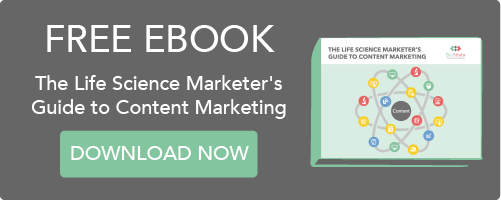
The next time you’re in a room with someone who’s dedicated their life to science and scientific inquiry, pay attention to their eyes as they eagerly explain a new concept, obscure theory or novel technology to their friends.
That sparkle, that enthusiasm, that intoxicating sense of wonder? It’s nothing short of magic. It’s this passion for learning about the world, and applying that knowledge to improve the lives of others, that drives many life science professionals into their industries.
But it’s not easy to communicate this feeling in life science marketing, and elicit it in your readers and target customers – especially in the B2B realm where people tend to puff out their chests, furrow their brows and go about their serious day as seriously as possible. But as much as they might come across as emotionless, functional machines, efficiently beeping and blooping their way to their next target, they’re still human. And, as such, they will always respond better to marketing messaging that they find intrinsically stimulating and engaging.
Here are some tips to think outside the box and up your fun game with your life science marketing:
Visual content is your best friend.
Whatever the picture-to-word exchange rate is in today’s economy, there’s little question that people respond better to marketing messaging when there is a strong visual element. This is especially true for life science marketing, which often has to communicate complex ideas as efficiently as possible, with a limited word count. It’s also more enjoyable for the reader. Just imagine dedicating a solid half hour to learning the molecular details of a new pharmaceutical product without any illustrations or diagrams to guide you along the way. Yes, it’s possible; but by the end of it you’ll be significantly more mentally drained and less inclined to learn more about how that product relates to your research, manufacturing or laboratory processes. There are also many ways to incorporate visual content into your marketing strategy without starting from scratch. For instance, you can turn an existing article into a SlideShare or infographic, or simply add supplementary images to convey your message more effectively.
Science is interesting to everyone – especially in bite sizes.
When (literal) Renaissance Man Paracelsus first penned “the dose makes the poison”, there’s a good chance he wasn’t thinking of 21st century digital marketing. But the basic idea is incredibly relevant, and a great thing to keep in mind when sprucing up your company’s marketing with educational, scientific content. For any piece of content, you just need the right dose of technical detail for your target reader and, before you know it, they’ll be wide-eyed and enthused like a puppy in the rain. For instance, you could create a series of small videos educating people about the wonders of something related to your product. In addition to guiding potential clients towards your product, you’re actively building brand awareness – which is a powerful tool in any marketer’s arsenal.
This approach is important in the battle for the attention of modern consumers; while many people love to consume long-form content such as application notes and whitepapers, others just want the top-level facts delivered to them as quickly as possible via graphics or videos. But that doesn’t mean you have to go creating everything from scratch. Instead, consider how your latest ebook can be quickly and easily converted into a series of short, sharp videos or blog posts (perhaps one covering the key points of each chapter) – you’ll get more bang for your buck and be more likely to capture the attention of your audience.
Show the human side of your company.
Showing the human side of your company means more than a profile pic and short bios of a select key figures on an “about us” page. It should translate into all of your marketing messaging – how business is conducted, and why it’s being conducted in the first place. A genuine human voice is worth so much in the B2B sphere precisely because you’re talking to people – with all their hopes, flaws, dreams (and various senses of humour). To get this right in your messaging, you need to think about why your company exists in the first place – usually to better society through advancements in science. And how do you do that? Through your products or services. As long as you avoid dehumanising your company and its offering, you should be able to relate to your reader on a genuine level. This is the best place for humour and fun in digital marketing – life science marketing in particular – as the reader is less likely to shrug it off as hollow pandering. For more on how to humanise your life science marketing strategy, check out our previous blog on the topic.
When it comes down to it, if you’re having fun creating your marketing content, there’s a good chance your reader will have fun reading or watching it too. Achieving this goes to the very heart of content marketing, as it prioritises the experience of your clients throughout their buyer journey (above and beyond purely promoting your offering). For more tips on planning and executing an effective content marketing programme for a life science company, download our eBook.





